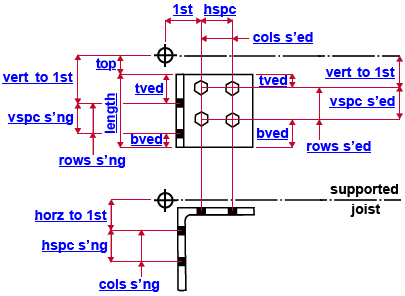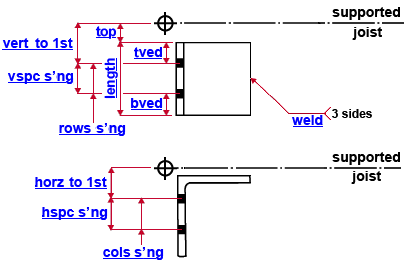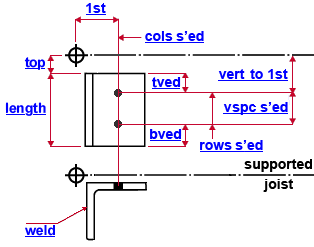"  NS Clip " & "
NS Clip " & "  FS Clip " flush framed joist connection design locks ( new )
FS Clip " flush framed joist connection design locks ( new )
|
||||
| " ( bolted to supported / bolted to supporting )  |
" (welded to supported / bolted to supporting )  |
|||
| " ( bolted to supported / welded to supporting )  |
|
|||
|
||||
User Defined Connections: Settings that are locked (
) in a user defined connection file will automatically be locked on a member edit window for which that file is the specified " User defined connection ." You can, if you so choose, manually lock additional settings on the member edit window, and your changes will be retained, through multiple processes, so long as you do not change to a different connection then switch back to the original user defined connection.
Joist Edit: To change a setting, first set it to locked (
). Related settings that are unlocked (
) may be updated, and the "
Left/Right end limit state " calculations will be updated. Settings that are locked (
) will not be changed by connection design , even if doing so might prevent a connection failure.
Connection design locks :
| Locks not dimensioned or called out on the drawing are marked ( not depicted ). |
![]() NS Clip /
NS Clip / ![]() FS Clip
FS Clip
Clip angle
Section size ( not depicted ): The angle material to be used for the clip angle on this side (NS or FS) of the joist's knife plate. For example, ' L4x3x5/16 '. The angle you enter here must exist in the local shape file, or validation will not accept your entry. To enter an angle section size, you can type in the section size that you want, or you can press the "file cabinet" browse button (
) and double-click a section size from the list of available angles in the local shape file .
Long leg to ( not depicted ): Supported or Supporting . If you want the long leg of the angle to fasten to the supporting beam or column, select ' Supporting '. If you want the long leg of the angle to fasten to the joist's knife plate, select ' Supported '.
Top of angle ( top ): The positive (+) or negative (-) distance from the reference line of the joist to the top edge of the angle (see example ).
Length of angle ( length ): The distance between the top edge of the angle and the bottom edge of the angle (marked " length " in the example ). If " Length of angle " is unlocked (
), changing the number of " Rows " (supported) or the distance " Vertical hole spacing " (supported) or the distance " Vertical 1st hole " (supporting) or the number of " Rows " (supporting) or the distance " Vertical hole spacing " (supporting) also changes the " Length of angle ."
Relative rotation ( not depicted ): The number of degrees relative to the orientation of the joist that the clip angle is to be rotated. A " Relative rotation " of ' 0 ' aligns the length of the clip angle parallel with the depth of the joist.
" Attachment to supported " = ' Welded '
Weld size ( not depicted ): The weld size used to weld the clip angle to the joist's knife plate. This setting applies to clip angles whose " Attachment to supported " is set to ' Welded ' in "
Connection specifications. " For bolted-to-supported clip angles, " Weld size " is not available as a connection design lock.
End connection failure message: Web weld strength exceeded
" Attachment to supported " = ' Bolted '
Bolt diameter ( not depicted ): The diameter of bolts for the leg of the clip angle that bolts to the supported joist's knife plate. You can either type a diameter (inches or mm), or you can select a bolt diameter from the combo box (
). The diameters that are listed in the combo box come from Home > Project Settings > Job > Bolt Settings > the " Available bolt diameters " list. The bolt diameter entered here, together with the " Hole type " (supported) set the diameter of holes in the leg to the supported joist's knife plate.
Hole type ( not depicted ): Standard round or Short slot or Oversized or Long slot or User slot #1 or User slot #2 . The hole type selected here, together with the " Bolt diameter " entered above, set the diameter of holes for bolting to the angle to the knife plate of the supported joist. This setting only applies to clip angles that are ' Bolted ' to the knife plate of the supported joist. For clip angles that are ' Welded ' welded to the knife plate of the supported joist, " Hole type " is not available as a connection design lock.

Rows ( rows s'ed ): The number of rows of holes in the leg of the clip angle that bolts to the knife plate of the supported joist (see example ). This setting only applies to clip angles that are ' Bolted ' to the knife plate of the supported joist. For ' Welded ' clip angles, " Rows " is not available as a connection design lock. If " Length of angle " is unlocked (
), changing the number of " Rows " also changes the " Length of angle ."
Vertical to 1st hole ( vert to 1st ): The distance from the joist reference line to the center of the top hole on the leg of the clip angle that bolts to the joist's knife plate (see example ).
Vertical hole spacing ( vspc s'ed ): The distance (center to center) between rows of holes in the leg of the clip angle that bolts to the knife plate of the supported joist (see example ). If " Length of angle " is unlocked (
), changing the " Vertical hole spacing " also changes the " Length of angle ." This option is only available for clip angles that are ' Bolted ' to the supported joist's knife plate. For ' Welded ' clip angles, " Vertical hole spacing " is not an option. Alternative: Instead of entering a single hole spacing distance, you can enter variable hole spacing. See the video and table below.
VIDEO 
Typing variable hole spacing for a joist clip angle works the same way as it does for beam connections.
Rows Spacing Result 5 3,5,3,3 4 spaces at 3", 5", 3" and 3" 5 3,5,2@3 4 spaces at 3", 5", 3" and 3" 5 3,5,3 4 spaces at 3", 5", 3" and 3"
(the last spacing -- 3 -- is repeated to fill the spaces that are required for the number of rows)5 3,5,3,3,2,3 End connection failure message (see below). Top vertical edge distance ( tved ): The distance from the top edge of the clip angle to the center of the nearest hole in the leg that bolts to the knife plate of the supported joist. See the example .
Bottom vertical edge distance ( bved ): The distance from the bottom edge of the clip angle to the center of the nearest hole in the leg that bolts to the supported joist's knife plate. See the example .
Columns ( cols s'ed ): The number of columns of holes on the angle leg that bolts to the joist's knife plate (see example ). In the example above, the number of " Columns " in the leg to the knife plate is ' 2 '.
Horizontal to 1st hole ( 1st ): The distance from the joist member line to the center of the nearest column of holes on the angle leg that bolts to the joist's knife plate (see example ).
Horizontal hole spacing ( hspc ): The distance (center to center) between columns of holes in the leg of the clip angle that bolts to the joist's knife plate (see example ).
" Attachment to supporting " = ' Welded '
Weld size ( weld ): The weld size used to weld the clip angle to the joist's knife plate. This setting applies to clip angles whose " Attachment to supporting " is set to ' Welded ' in "
Connection specifications. " For bolted-to-supporting clip angles, " Weld size " is not available as a connection design lock.
End connection failure message: Weld strength to supporting member exceeded
" Attachment to supporting " = ' Bolted '
Bolt diameter ( not depicted ): The diameter of bolts for the leg of the clip angle that bolts to the supporting beam or column. You can either type a diameter (inches or mm), or you can select a bolt diameter from the combo box (
). The diameters that are listed in the combo box come from Home > Project Settings > Job > Bolt Settings > the " Available bolt diameters " list. The bolt diameter entered here, together with the " Hole type " (supporting) set the diameter of holes in the leg to the supporting member.
Hole type ( not depicted ): Standard round or Short slot or Oversized or Long slot or User slot #1 or User slot #2 . The hole type selected here, together with the " Bolt diameter " entered above, set the diameter of holes for bolting to the angle to the supporting beam or column.

Rows ( rows s'ng ): The number of rows of holes in the clip angle leg to the supporting member. In the example above, this number would be ' 2 '. ' 0 ' is an allowable entry. If " Length of angle " is unlocked (
), changing the number of " Rows " also adjusts the " Length of angle ."
Vertical 1st hole ( vert to 1st ): The distance from the joist reference line to the center of the top row of holes on the leg of the clip angle that bolts to the supporting beam or column -- see example .
Vertical hole spacing ( vspc s'ng ): The distance (center-to-center) between holes the clip angle leg that bolts to the supporting beam or column -- see example . If " Length of angle " is unlocked (
), changing the " Vertical hole spacing OSL " distance causes an automatic recalculation of the " Length of angle ." Alternative: Instead of entering a single hole spacing distance, you can enter variable hole spacing. See the video and table below.
VIDEO 
Typing variable hole spacing for a joist clip angle works the same way as it does for beam connections.
Rows Spacing Result 5 3,5,3,3 4 spaces at 3", 5", 3" and 3" 5 3,5,2@3 4 spaces at 3", 5", 3" and 3" 5 3,5,3 4 spaces at 3", 5", 3" and 3"
(the last spacing -- 3 -- is repeated to fill the spaces that are required for the number of rows)5 3,5,3,3,2,3 End connection failure message (see below). Top vertical edge distance ( tved ): The distance from the top edge of the clip angle to the center of the nearest hole in the leg that bolts to the supporting beam or supporting column. See the example .
Bottom vertical edge distance ( bved ): The distance from the bottom edge of the clip angle to the center of the nearest hole in the leg that bolts to the supporting beam or supporting column. See the example .
Columns ( cols s'ng ): The number of columns of holes in the leg of the clip angle that bolts to the supporting beam or column. For the above example , this number is ' 2 '.
Horizontal 1st hole ( horz to 1st ): The horizontal distance from the work line of the supported joist to the center of the first row of holes in the leg of the clip angle that bolts to the supporting member (see example ).
Horizontal hole spacing ( hspc s'ng ): The horizontal distance between columns of holes on the leg of the angle that bolts to the supporting member (see example ). This applies to clip angles with more than one " Columns " (supporting).







